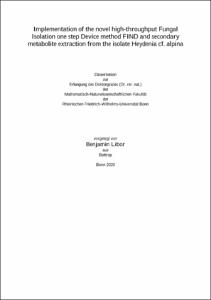Implementation of the novel high-throughput Fungal Isolation one step Device method FIND and secondary metabolite extraction from the isolate Heydenia cf. alpina

Implementation of the novel high-throughput Fungal Isolation one step Device method FIND and secondary metabolite extraction from the isolate Heydenia cf. alpina

| dc.contributor.advisor | König, Gabriele M. | |
| dc.contributor.author | Libor, Benjamin | |
| dc.date.accessioned | 2021-07-13T13:19:53Z | |
| dc.date.available | 2021-07-13T13:19:53Z | |
| dc.date.issued | 13.07.2021 | |
| dc.identifier.uri | https://hdl.handle.net/20.500.11811/9217 | |
| dc.description.abstract | Fungi are an important source of bioactive metabolites. The cultivation of source organisms is a crucial step in natural product isolation. With standard isolation methods for fungi it is difficult to isolate rare und underexamined fungi from environmental samples. The Fungal one-step IsolatioN Device (FIND) technology allows the isolation of rare fungi from terrestrial and marine samples. The FIND comprises a multi-chambered micro agar plate, where initially only one fungal part (e.g., hyphal cell, mycelial fragment or spore) is located in each chamber. After inoculation the device is placed back into the original natural environment of sample collection, to ensure favourable growth conditions. A comprehensive analysis of state-of-the-art isolation techniques for filamentous fungi emphasises the advantages of the FIND method compared to the standard isolation methods.
With the FIND, it was possible to isolate 12 rare and underexamined axenic fungal cultures directly from their sample sources, i.e. terrestrial soil, sea sediment and seawater, without any purification or passaging steps. The taxonomy of nine of these strains could be determined to species level by DNA sequencing. One of the isolated fungi, i.e. Heydenia cf. alpina (strain 824) was never before investigated chemically and cultures of our strain yielded three novel compounds, namely heydenoic acid A (1), heydenoic acid B (2) and (3E,6E)-4,6,8-trimethyldodeca-3,6-diendioic acid (8). The first two compounds belong to the sesquiterpene family of bergamotenes. Using the latest approaches, i.e. HRMS based dereplication (GNPS) and deep learning NMR guided structure elucidation (SMART), fascinating insights into the metabolome of Heydenia cf. alpina were displayed, after challenging cultures of this strain with varying (partially extreme) conditions (OSMAC). | en |
| dc.description.abstract | Pilze bilden eine der wichtigsten Quellen für bioaktive Sekundärmetabolite. Die Kultivierung von Quellorganismen spielt eine entscheidende Rolle bei der Isolierung von Naturstoffen. Mit herkömmlichen Methoden ist es jedoch diffizil seltene und wenig erforschte Pilze aus Umweltproben zu isolieren. Die Fungal one-step IsolatioN Device (FIND) Technologie ermöglicht die Isolierung von seltenen Pilzen aus marinen und terrestrischen Proben. Das FIND beinhaltet Mikroagarplatten in getrennten Kammern, welche zuvor mit einem einzigen Pilzbestandteil (z.B. Hyphenzelle, Myzelfragment oder Spore) beladen wurden. Nach der Inokulation wird die Vorrichtung in die Umgebung der Probenentnahme zurückgeführt um optimale Wachstumsbedingungen zu garantieren. Eine vollständige Revision der gängigsten Isolierungsmethoden für filamentöse Pilze stellt die Vorteile der FIND Methode deutlich heraus.
Mithilfe der FIND Methode wurden 12 seltene und wenig erforschte Stämme in Reinkultur direkt aus der Probe isoliert, welche aus Bodenproben, Meeressediment oder Meerwasser bestand, ohne die Notwendigkeit zusätzlicher Aufreinigungsschritte. Die Taxonomie von 9 der 12 Stämme konnte mittels DNA-Sequenzierung bis auf Spezieslevel bestimmt werden. Einer der isolierten Stämme, Heydenia cf. alpina (Stamm 824), wurde bisher noch nicht auf seine Chemie hin untersucht und Kulturen unseres Isolats produzierten drei neuartige Naturstoffe, nämlich heydenoic acid A (1), heydenoic acid B (2) und (3E,6E)-4,6,8-trimethyldodeca-3,6-diendioic acid (8). Die ersten beiden gehören zur Naturstoffklasse der Bergamotensesquiterpene. Durch den Einsatz modernster Analysetechniken, z.B. HRMS basierte Dereplizierung (GNPS) und deep learning NMR vermittelte Strukturaufklärung (SMART), konnten faszinierende Einblicke in das Metabolom von Heydenia cf. alpina gewonnen werden, nachdem der Stamm unterschiedlichen, teils extremen Wachstumsbedingungen ausgesetzt wurde (OSMAC). | en |
| dc.language.iso | eng | |
| dc.rights | In Copyright | |
| dc.rights.uri | http://rightsstatements.org/vocab/InC/1.0/ | |
| dc.subject | Heydenia cf. alpina | |
| dc.subject | Naturstoffe | |
| dc.subject | Fungal one-step IsolatioN Device (FIND) | |
| dc.subject | isolation methods for fungi | |
| dc.subject | structure elucidation | |
| dc.subject | Isolierungsmethoden für Pilze | |
| dc.subject | Strukturaufklärung | |
| dc.subject.ddc | 500 Naturwissenschaften | |
| dc.subject.ddc | 570 Biowissenschaften, Biologie | |
| dc.title | Implementation of the novel high-throughput Fungal Isolation one step Device method FIND and secondary metabolite extraction from the isolate Heydenia cf. alpina | |
| dc.type | Dissertation oder Habilitation | |
| dc.publisher.name | Universitäts- und Landesbibliothek Bonn | |
| dc.publisher.location | Bonn | |
| dc.rights.accessRights | openAccess | |
| dc.identifier.urn | https://nbn-resolving.org/urn:nbn:de:hbz:5-62850 | |
| ulbbn.pubtype | Erstveröffentlichung | |
| ulbbnediss.affiliation.name | Rheinische Friedrich-Wilhelms-Universität Bonn | |
| ulbbnediss.affiliation.location | Bonn | |
| ulbbnediss.thesis.level | Dissertation | |
| ulbbnediss.dissID | 6285 | |
| ulbbnediss.date.accepted | 04.05.2021 | |
| ulbbnediss.institute | Mathematisch-Naturwissenschaftliche Fakultät : Fachgruppe Pharmazie / Pharmazeutische Biologie | |
| ulbbnediss.fakultaet | Mathematisch-Naturwissenschaftliche Fakultät | |
| dc.contributor.coReferee | Schäberle, Till F. | |
| ulbbnediss.contributor.gnd | 1239089643 |
Dateien zu dieser Ressource
Das Dokument erscheint in:
-
E-Dissertationen (4373)




